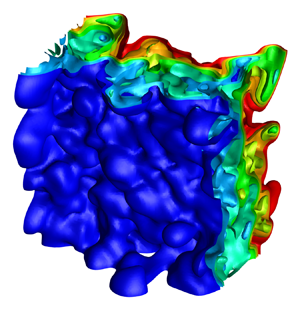Crossref Citations
This article has been cited by the following publications. This list is generated based on data provided by
Crossref.
Zhou, Ye
2021.
Turbulence theories and statistical closure approaches.
Physics Reports,
Vol. 935,
Issue. ,
p.
1.
Xiao, Meng-Juan
Hu, Ze-Xi
Dai, Zi-Huan
and
Zhang, You-Sheng
2022.
Experimentally consistent large-eddy simulation of re-shocked Richtmyer–Meshkov turbulent mixing.
Physics of Fluids,
Vol. 34,
Issue. 12,
Wang, Xiaole
and
Xiao, Zuoli
2022.
Transition-based constrained large-eddy simulation method with application to an ultrahigh-lift low-pressure turbine cascade flow.
Journal of Fluid Mechanics,
Vol. 941,
Issue. ,
Chen, Feng
Xu, Aiguo
Zhang, Yudong
Gan, Yanbiao
Liu, Bingbing
and
Wang, Shuang
2022.
Effects of the initial perturbations on the Rayleigh—Taylor—Kelvin—Helmholtz instability system.
Frontiers of Physics,
Vol. 17,
Issue. 3,
Qi, Han
Li, Xinliang
Hu, Running
and
Yu, Changping
2022.
Quasi-dynamic subgrid-scale kinetic energy equation model for large-eddy simulation of compressible flows.
Journal of Fluid Mechanics,
Vol. 947,
Issue. ,
Li, Jianming
Ding, Juchun
Luo, Xisheng
and
Zou, Liyong
2022.
Instability of a heavy gas layer induced by a cylindrical convergent shock.
Physics of Fluids,
Vol. 34,
Issue. 4,
Wang, Rui
Song, Yang
Ma, Zongqiang
Zhang, Yang
Wang, Jun
Xu, Yaofeng
Wang, Lili
and
Wang, Pei
2023.
Scale-to-scale energy transfer in rarefaction-driven Rayleigh–Taylor instability-induced transitional mixing.
Physics of Fluids,
Vol. 35,
Issue. 2,
Luo, Tengfei
Wang, Yunpeng
Yuan, Zelong
Jiang, Zhou
Huang, Wenfeng
and
Wang, Jianchun
2023.
Large-eddy simulations of compressible Rayleigh–Taylor turbulence with miscible fluids using spatial gradient model.
Physics of Fluids,
Vol. 35,
Issue. 10,
Han, Xu
Yu, Bin
and
Liu, Hong
2023.
Mixing mechanisms in the view of mixing indicators: from passive-scalar mixing to variable-density mixing.
Metascience in Aerospace,
Vol. 1,
Issue. 1,
p.
1.
2023.
Heat transfer effects on multiphase Richtmyer–Meshkov instability of dense gas–particle flow.
Physics of Fluids,
Vol. 35,
Issue. 5,
Yang, Tao
Lin, Chuandong
Li, Demei
and
Lai, Huilin
2023.
Influence of Density Ratios on Richtmyer–Meshkov Instability with Non-Equilibrium Effects in the Reshock Process.
Inventions,
Vol. 8,
Issue. 6,
p.
157.
Sadler, James D.
Louie, Carlton
and
Zhou, Ye
2023.
Intricate structure of the plasma Rayleigh–Taylor instability in shock tubes.
Physics of Plasmas,
Vol. 30,
Issue. 2,
Huang, Peng
Chen, Kuanyu
Peng, Huaiwu
Lee, Hsu-Chew
Shi, Yipeng
Xiao, Zuoli
Chen, Shiyi
and
Wan, Minping
2023.
A constrained subgrid-scale model for passive scalar turbulence.
Acta Mechanica Sinica,
Vol. 39,
Issue. 4,
Wu, Qi
Zhang, Yousheng
Meng, Baoqing
Shi, Yipeng
and
Tian, Baolin
2024.
Freeze out of multi-mode Richtmyer–Meshkov instability using particles.
Physics of Fluids,
Vol. 36,
Issue. 6,
Sadler, James D.
Powell, Philip D.
Schalles, Mark
Louie, Carlton
Jacobs, Jeffrey W.
and
Zhou, Ye
2024.
Simulations of three-layer Richtmyer–Meshkov mixing in a shock tube.
Physics of Fluids,
Vol. 36,
Issue. 1,
Si, Yingming
Li, Shuai
Meng, Baoqing
Wang, Chun
and
Tian, Baolin
2024.
A dominant dimensionless number and theoretical model for the evolution of multiphase Richtmyer–Meshkov instability.
Physics of Fluids,
Vol. 36,
Issue. 1,
Luo, Tengfei
Li, Zhijie
Yuan, Zelong
Peng, Wenhui
Liu, Tianyuan
Wang, Liangzhu (Leon)
and
Wang, Jianchun
2024.
Fourier neural operator for large eddy simulation of compressible Rayleigh–Taylor turbulence.
Physics of Fluids,
Vol. 36,
Issue. 7,
Sun, Fang-ping
Song, Yu
Wang, Yu-hui
and
Zhang, You-sheng
2024.
Improved mixing-width model for the linear stage of reshocked Richtmyer–Meshkov turbulence.
Physics of Fluids,
Vol. 36,
Issue. 8,
Lian, Lingyan
Lin, Chuandong
Li, Demei
and
Lai, Huilin
2025.
Investigating the effect of relaxation time on Richtmyer–Meshkov instability under reshock impact: a two-component discrete Boltzmann method study.
Communications in Theoretical Physics,
Vol. 77,
Issue. 8,
p.
085602.
Li, Quanzheng
and
Wang, Gang
2025.
Residual stress relation between averaged and filtered compressible flows.
Journal of Fluid Mechanics,
Vol. 1020,
Issue. ,



